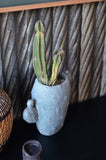During the hot days of summer, plants are busy both in the garden and in the house, pushing new growth, flowering, and producing fruits and vegetables. These actions require proper watering techniques.
Watering is strictly dependent on your soil structure, environment, and type of plant. To determine your soil structure, take a handful of your soil, squeeze it in your hand, if it falls apart it is course and if it adheres it is moist. Moist soil has

the capacity to hold water and soil that crumbles will drain quickly. Depending on the environment each could be an asset. During drought, a moist soil will assist in water retention, and during rainy times you would prefer draining soil so plants can breathe.
Most plants appear the same when they are either overwatered or underwatered – they fold over and leaves wilt. The only true way to tell if you

should apply water is to poke into the soil to the depth of 1-2 inches and see if it is cool, moist, and darker in color than the surface soil. Plants will fold to protect themselves from transpiration on sunny days as the roots can not hydrate the leaves fast enough but, it does not mean that they need water. The plants that are protecting themselves will stand back and leaves will unfurl at night. If the soil is dry, warm, and light in color deep root water.

All outdoor plants can live on one inch of gentle rain weekly and best if at one time. The water will penetrate the ground enough for the roots to follow and establish a good feeder root system. This will keep the plant healthy. Deep root watering is best if applied at ground level with a soaker hose, hand watering, or a wand. If you use sprinklers, you lose 35% of the water applied to evaporation. Water so that the leaves are never wet in the hottest part of the day as this can cause issues with transpiration. Also, leaves should never be wet going into evening with anything but rain as rain falls through the atmosphere collecting nitrogen and oxygen which both help plants. Well water and tap water have neither and most have other compounds that can harm plants.
Evaluate house plant soil in the same way and water so that the water flows into the saucer. If the plant does not take the water up out of the saucer dump the excess. During the dormant season or when the houseplants are not growing it is always best to check prior to watering as they will need less. The main cause of houseplant death is overwatering.
Plants that are in hanging baskets or above ground dry quickly, as air and heat are hitting all areas of their root system. Water daily if needed but remember that they will require more nutrition than a plant in the ground, as the amount of soil for the roots to collect nutrients is restricted.
So, to be the best gardener and have the healthiest plants, you should get to know your soil consistency, understand the needs of your plant, and water them properly.

























